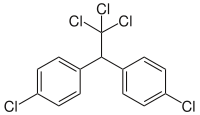
Figure: Molecular structure of DDT
ALS offering for DDT testing
|
Matrix |
LOQ |
Sample volume |
|
Soil |
0.01 mg/kg DW |
10 g |
|
Sediment |
0.01 mg/kg DW |
10 g |
|
Water |
0.01 µg/L |
0.5 L |
Overview
DDT was first synthesised in 1874 but it was not until 1939 that Dr. Paul Miller discovered the insecticidal properties of the compound. Dr. Miller later received the Nobel price for this discovery.
DDT was used extensively during the later part of World War II to fight malaria and typhus and later on as an agricultural insecticide.
DDT was banned in most countries during the 70’s and 80’s however some countries used and produced DDT into the 21st century. Today there is only limited use of DDT used for indoor spraying to fight malaria.
In the environment DDT is metabolised to DDD and DDE
Toxicity
DDT is classified as moderately toxic and moderately hazardous. DDT is an endocrine disruptor and is likely to be carcinogenic.
Table: International threshold values for DDT
|
Country |
Matrix |
Limit |
|
Sweden |
Soil |
0.1 (1) mg/kg DW1 |
|
The Netherlands |
Soil |
0.01-4 mg/kg DW4 |
|
The Netherlands |
Sediment |
0.002 mg/kg2 |
|
Sweden |
Sediment |
0-6 µg/kg3 |
|
The Netherlands |
Water |
0.4 µg/l2 |
|
The Netherlands |
Water |
0.004-0.01 ng/l4 |
|
Norway |
Water |
0.001-0.25 µg/l 5 |
1. Swedish EPA report 5976. Limit depending on classification
2. Crommentuijn et al., Journal of Environmental Management 58 (2000): 297
3. Swedish EPA report 4914. Limit depending on classification
4. VROM (2000) Streefwaarden en interventiewaarden bodemsanering. Staatscourant 24 february
2000/39. Limit depending on classification.
5. 2229/2007, Norwegian Pollution Control Authority. Limit depending on classification


